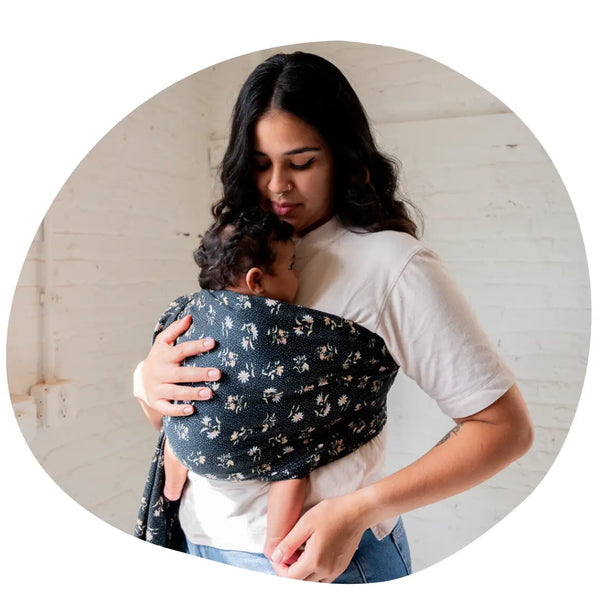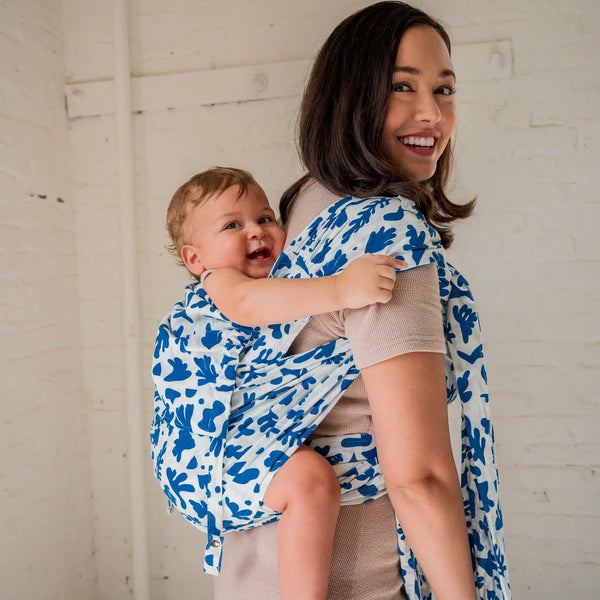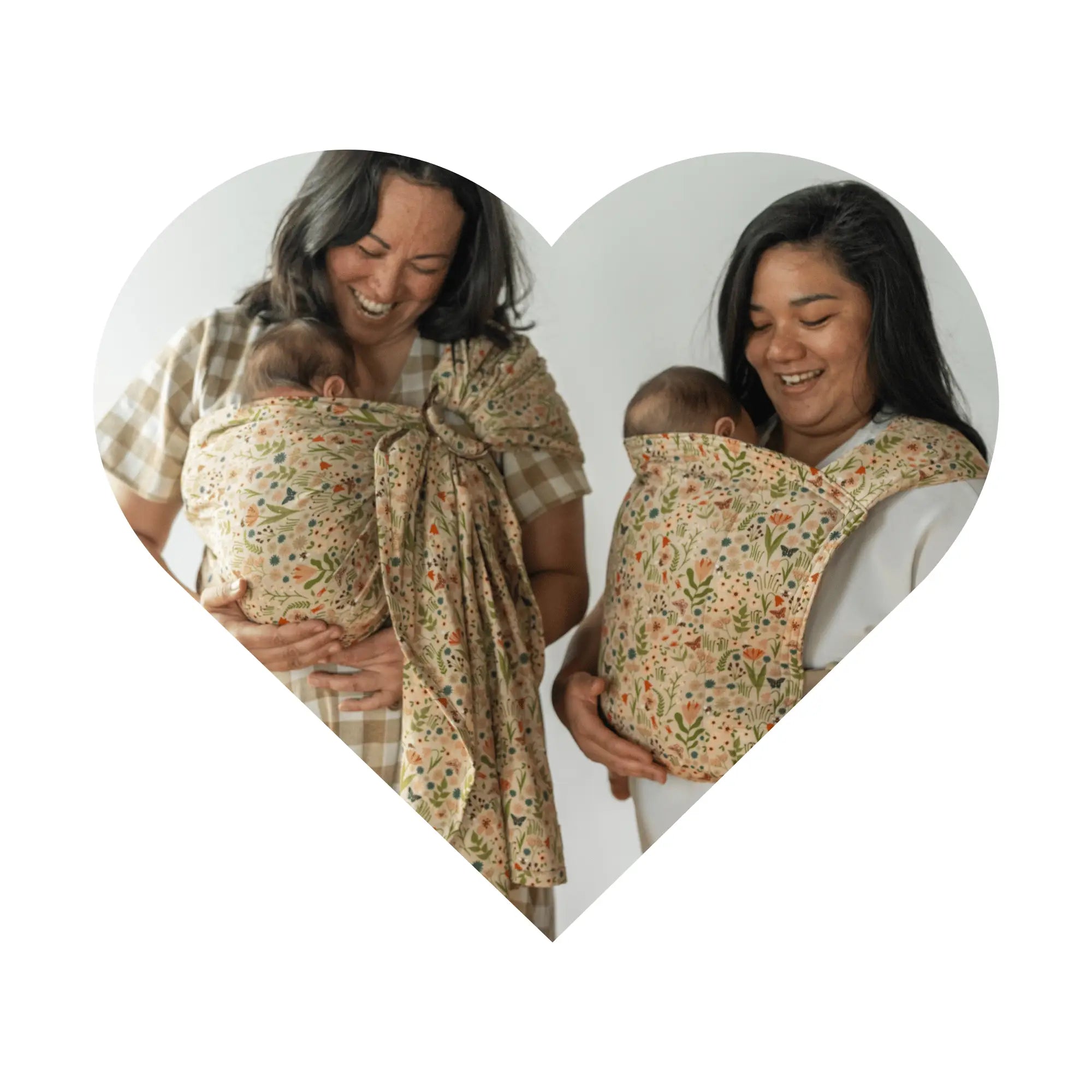Babywearing & Black History: Thousands of Years of Tradition
Babywearing is a rich cultural tradition with deep roots around the world. For thousands of years, babywearing has allowed caregivers to keep their babies close, safe, and connected. This Black History Month, hope&plum invites you to explore the history of Black babywearing.
Babywearing in Africa
Like those in many places around the world, people across the African continent have been babywearing for thousands of years. “The lithograph of the women depicted a painting on the wall of the Tomb of Ann’a located on the Theban necropolis (mount Shêkh ‘Abd-el-Qurna) in Egypt. It was built in the Middle Kingdom, during the 18th dynasty, around 1500 bce (3500 years ago)” (Wyndham, 2019). The picture below is believed to depict babies carried in linen bags that are part of the women’s clothing.
In many African cultures, a long piece of fabric is traditionally used for babywearing. “In African cultures, women would wrap a long piece of non-stretch fabric around their bodies, as their little one lay asleep on their back. They would tie and tuck the loose ends underneath their breast and proceed upon their day, babe in tow” (Sellers-Jackson, 2022). In East Africa, as in modern-day Tanzania and Kenya, kangas are the traditional babywearing material. The kanga “...is a traditional wrap with an immense cultural significance. This special garment consists of 1m x 1.5m in size and offers people the versatility to carry or wear it as they wish! Not only that - each piece gets its own unique character through its woven frame (Swahili: pindo) and aphorism at center field( mji)” (Adedokun, 2023).
These beautiful kangas can be worn in different ways. “In countries such as Tanzania and Kenya, babies are often wrapped on a wearer’s back or hip in a traditional kanga cloth; the fabric is spread over one shoulder and under the other and tied in front in a traditional sling carry pattern” (Lee, 2021).
Variations can be seen as we move west across the continent. “Additionally, In Nigeria, the beautiful Yoruba cloth is used in a special way-as an ancient tradition of baby carrying. Tied around mother's waist with loving care, it cradles the little one close against her back and allows mom to go about her daily activities hands free! The beautifully hand loomed cotton fabric comes plain woven with fringed edges for that final flourish - proving yet again how different cultures have unique ways of showing their deep affection towards children since time immemorial” (Adedokun, 2023).
“In Ghana, babies are often carried on a caregiver’s lower back with the fabric secured around the caregiver’s torso, providing free movement of the arms. Depending on the region, a torso carry may be tied with a knot or simply tucked into itself to hold the baby in place… There are many different names for traditional cloth baby wraps—in Mozambique, it’s called a capulana, and in Nigeria, a wrapper or lappa” (Lee, 2021). Whatever the name, style, or type of carry, babywearing throughout Africa has been an important parenting tool that allows mothers to keep their babies close while also caring for their other children, working, or traveling.
The Americas
As people across Africa were captured or conquered and then enslaved, their babywearing practices went with them, at least at first. “When captured Africans came to North America, they brought the tradition with them and you could see Black moms working in the fields with their babies tied to them not for the purpose of bonding but more likely to keep them safe and in their sight for protection” (Successful Black Parenting Staff, 2022). However, babywearing was not practiced by all enslaved mothers. “By necessity the whole slave community needed to take responsibility for the rearing of slave children. Mothers were as a rule expected to return to work and babies were looked after by the very old and the very young” (Lee, 2011). Whether outright prohibited by enslavers or falsely labeled as too dangerous for babies, babywearing was systematically stripped from the African diaspora in the Americas. The result? A cruel effort to dismantle one of the most powerful forms of connection and care between parent and child.
While there are efforts to shift these perceptions, babywearing remains less visible in Black culture than it could be or once was. However, growing movements and voices are working to bring it back into the spotlight, and we'll explore that more later.
Black Babywearing Today
Babywearing continues to be an integral tool of African parenting. Here is a picture of a woman babywearing in a market in Brikama, Gambia in 2011.
And here is a man babywearing as photographed for the World Health Organization and published in 2010.
An article from 2004 shows that strollers were still not the preferred gear for baby transport. “Across Africa women can be seen carrying sleeping or sometimes giggling babies on their backs, swathed in cloth. The babies move to the sway of their mothers' hips, synchronised throughout the day… The stroller has sparked debate among African paediatricians who think the device - first crafted as a labour-saving tool for the European middle class - may damage the relationship between a mother and a child” (Wax, 2004). The importance placed on the relationship between caregivers and children is exactly why babywearing has remained such a common practice in many African countries.
Representation Matters
Because babywearing has been such an integral part of African parenting culture for centuries, it is even more important that Black parents in the Americas and Europe can find representation in this practice. Black women, who had long embraced babywearing as a vital part of their cultural connection, were forced to assimilate into a society that prioritized strollers and disconnection over nurturing bonds and the natural closeness of babywearing. “We acknowledge the deep rich roots that have been erased. We acknowledge the history of where our favorite Ergobaby Carrier and so many other carriers have come from... We acknowledge that THIS is not a new idea. Attachment parenting is not a new idea. It has been here and adopted, and oftentimes whitewashed.” (Sellers-Jackson, 2022).

In fact, one of the first publicly sold and marketed soft baby carriers was “invented” by a white woman who went to Africa in the middle of the twentieth century. Ann Moore was a pediatric nurse who went on the first Peace Corps medical team’s trip to Togo, now the Togolese Republic, in 1962. While there, she observed many local mothers carrying their babies on their backs. She was amazed at the high levels of connection and low levels of crying she observed in these babies. When she returned to the United States and had a baby of her own, she wanted to try babywearing for herself. But she didn’t know any local families who wore their babies. She tried the methods she observed in Togo, but without the communal knowledge and support, failed to make back-wrapping her infant work for her. So she and her mother sewed their own carrier, claiming to be the first soft structured carrier in the US. They called it the Snugli, and soon manufactured and sold it to the public. While Ann Moore has since acknowledged that the Togo people inspired her, the truth remains that she wrongfully claimed credit for inventing the baby carrier, undermining the true origins of the carrier and the cultural heritage it came from.

This is one of the reasons Black Babywearing Week has been celebrated each year in mid-June since 2018. “Black Babywearing Week is necessary. The reality is that society is not always inclusive. So if we are not being represented in the mainstream, we are doing this ourselves. It’s about creating space and celebrating the rich ancestral history of babywearing, showcasing where we are at now, sharing stories and looking forward to the changes we can make” (Knowles, 2019).
In an interview with Kayleigh Medeiros from Heritage Baby during Black Babywearing Week in 2022, Kayleigh stated that the week “...exists out of a need for awareness. So many people don't know the more malicious history of babywearing and how it was one of many practices enslaved people were stripped of” (Meet Kayleigh Medeiros from Heritage Baby, 2022).
As you hold your own little ones close in your favorite carriers, consider how the designs for those carriers could be modeled after African babywearing and the strong cultural practice of nurturing your baby through babywearing.
Summary
Babywearing has deep cultural roots, especially in African traditions, where caregivers have used fabrics like kangas, wrappers, and capulanas for centuries.
Modern babywearing owes much to African traditions, including innovations like the Snugli carrier, inspired by practices observed in Togo.
Babywearing remains a vital practice in African parenting, emphasizing connection, nurturing, and practical caregiving solutions.
Black Babywearing Week, celebrated since 2018, highlights representation, ancestral history, and the need for inclusivity in babywearing communities.
References
Adedokun, T. (2023, January 20). The african tradition of baby wearing: It’s origins and it’s benefits for your newborn. Ade + Ayo. https://adeandayo.com/blogs/journal/the-african-tradition-of-baby-wearing-its-origins-and-its-benefits-for-your-newborn?srsltid=AfmBOoruH_l1zjzKFzh92H7mt6Hss2dElV6KF-5aLCkzX2ZhnxHDu6hq
Knowles, R. (2019, June 21). Why black babywearing week matters, by dr ilhan omar - carrying matters. Carrying Matters. https://www.carryingmatters.co.uk/2019/06/21/why-black-babywearing-week-matters-by-dr-ilhan-omar/
Lee, J. (2021, September 13). Here’s what you should know about babywearing and cultural appropriation. Today’s Parent. https://www.todaysparent.com/baby/baby-development/babywearing-and-cultural-appropriation/
Lee, W. (2011). What was it like to be a child slave in america in the nineteenth century ? The National Archives. https://www.semanticscholar.org/paper/What-Was-it-Like-to-be-a-Child-Slave-in-America-in-Rose/8ce60600393e322050d8a30a3a372250e11d3c7e
Meet kayleigh medeiros from heritage baby. (2022, June 26). Cbws.org. https://www.cbws.org/blog/Heritagebaby
Sellers-Jackson, B. (2022, February 22). Because babywearing is black history month. Ergobaby.com; Ergobaby. https://ergobaby.com/blog/post/because-babywearing-is-black-history-month?srsltid=AfmBOoq9hE88yTroW1LCKUdmwndMYoQUfKCfOdwdb64fO1nQTJa_S8Qm
Successful Black Parenting Staff. (2022, April 12). What do you know about black baby wearing week? | successful black parenting magazine. Successful Black Parenting Magazine. https://successfulblackparenting.com/2020/06/17/what-do-you-know-about-black-baby-wearing-week/
Wax, E. (2004, June 18). “In Africa we carry our children so they feel loved.” The Guardian. https://www.theguardian.com/theguardian/2004/jun/18/guardianweekly.guardianweekly12#
Welliver, M. (2016, May 4). The Snugli story. American Nurse. https://www.myamericannurse.com/the-snugli-story/
Wyndham, A. (2019, September 24). Syrian baby carriers in ancient egypt. The Baby Historian. https://thebabyhistorian.com/2019/09/24/syrian-baby-carriers-in-ancient-egypt/














